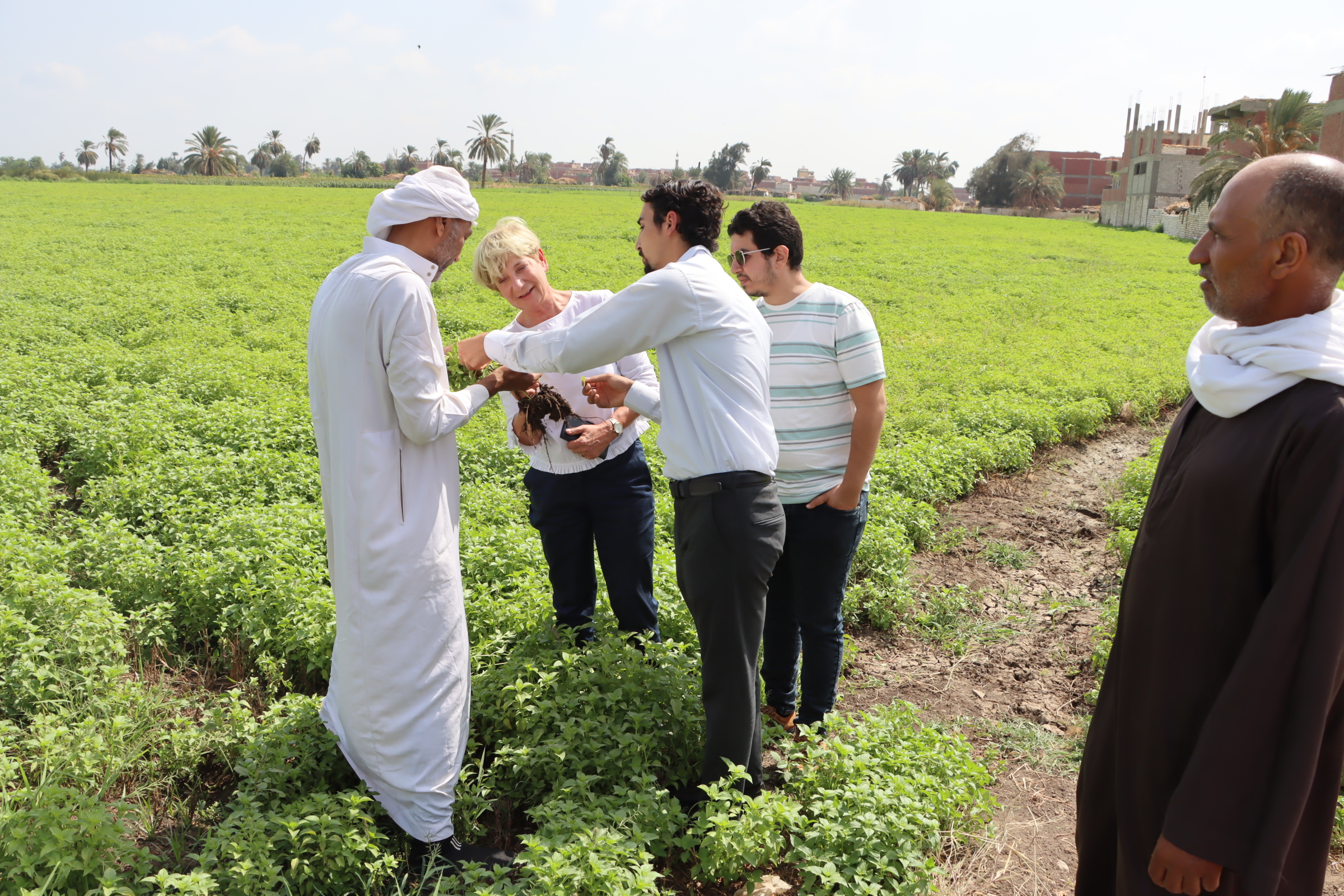Many people were wide-eyed when they heard that our next audit trip was to Egypt. Because Egypt stands for the vacation area at the Red Sea, for sun, beach and rest. More than a million sun-seeking vacationers „conquer“ Hurghada every year. But that was not the target of our audit trip to suppliers. Learn more in the following travel report….
Egypt the land of herbs and spices
Spices play an important role in Egyptian cuisine, as people like to cook hot and spicy food. In addition to the local consumption of spices, Egypt exports herbs and spices for 150 million USD per year. Mainly anise and cumin, but also basil, marjoram, chives and parsley. But how does this work in a country that – away from the major tourist areas – is bitterly poor and small in agricultural land? We wanted to know: what agricultural structures are there and which reliable suppliers can we find for our customers.
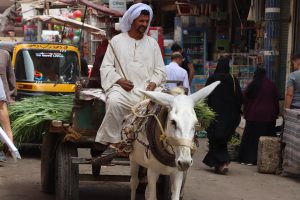
Background Agriculture in Egypt
Egypt is an agricultural country: agriculture contributes about 14% of GDP. Fifty-three percent of the population lives in rural areas, where livelihoods depend directly or indirectly on the agricultural sector.
Egyptian agriculture is characterized by small and fragmented land ownership. About 80% of all landowners own agricultural land that is less than or equal to 5 feddans[1]. 50% of all landholdings have an area of less than 0.4. There is an imbalance in the country between the cultivation of high-value crops and strategic crops (cotton-wheat-rice-corn).
[1] 1 Feddan = 0,42 Hektar
The main crops grown in Egypt include sugar beets, sugar cane, wheat, corn, rice, tomatoes, potatoes, onions, oranges, grapes and dates. Sugarcane is the most important crop in the country.
About 80% of the crops are not of high enough quality to be shipped to export markets. This is because European requirements are high: good qualities, no pesticides, no contamination, products from sustainable agriculture.
Sustainable agriculture in Bani Suwaif
Bani Suwaif is located 120 km south of Cairo and is part of the Nile flood plain with loamy, fertile soils. Here we learn: Agriculture of the future means working with nature – not against it. Artificial fertilizers and synthetic chemical pesticides and herbicides have become very expensive due to the Ukraine war, because they are produced in an energy-intensive way. And: sustainable living and working succeeds, in regional, preferably closed cycles. This is possible, because agriculture is the only branch of industry in the world that can produce its yields with the help of the sun alone, i.e. photosynthesis, and does not have to work extractively, i.e. on exploitation.
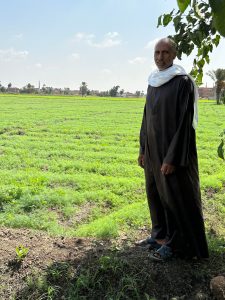
We visit the farmer of our Egyptian trading partner. A farmer who grows basil, parsley and chives on his plots. We can feel how convinced he is of his work. Proudly shown the fields where currently basil is about to be cut for the third time. Large and vigorous plants, a good 30 cm high. The plots are relatively large – so large that one plot of fresh basil can become a container of dried basil: six tons of dried product! One batch from one field – not a batch mixed together from many farmers. This makes analyses safer and easier.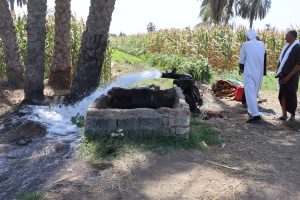
Between the plants in the field there are irrigation channels. From pumps with well water, the filtered groundwater is directed into the fields and irrigates the plants. The farmer shows his pumps and explains to us that the surface water, unfiltered, contains too many pollutants. But his groundwater is filtered through the layers of earth and is clean – he checks the water monthly.
The management behind it trains the farmers in water quality, pollutants, plant characteristics and desired qualities. Pesticides, herbicides and artificial fertilizers are not used – not only because they have become too expensive in the Corona era, but also because our plantation owner with his processor has a lot of know-how and knows how precise the European regulations for pesticides and fertilizer residues are. – Often in ranges of 0.01 mg/kg. He uses no pesticides and only organic fertilizer – and he gets it from his animals. Unwanted plants such as weeds are not destroyed / suppressed with chemicals, but removed quite classically by hand.
Plantations and Processors
There are a number of small plantations that supply their products to Egyptian processors. These ensure that the fresh produce is dry enough for stable storage, clean and post-cleaned, and thus fit for export. Processors refine the produce that farmers have grown, tended and harvested by hand.
This makes the farmers dependent on the processors and lengthens the chain of different trade stages. But – European importers have high demands on quality and want uniform products. They import herbs from Egypt in whole containers with high analytical effort. Therefore, importers need consistent qualities from mono batches. From one farmer and from one harvest.
Over the last few years, the number of larger family farms that were able to expand their cultivated land through marriage has grown. These small farms became larger farms. The larger the harvest volumes became, the more the growers wanted to become independent of local processors. And so there are now some (large) farmers who also process. Among them are also large and very large processors with more or less modern facilities.
Processors and Exporters
Above a certain size, the processors export themselves. This means they have everything in one hand: qualities, quantities and post-cleaning. We looked at some productions and are amazed at the differences that exist.
Language skills (not everyone speaks English in Egypt), European education, informedness about labor and product hygiene, existing GFSI certifications, sustainable practices… There are a lot of parameters that are crucial for us when choosing a suitable supplier.
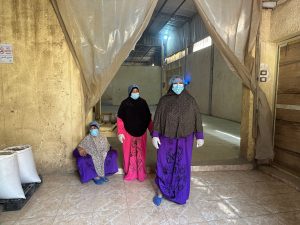
On our trip we saw many different processors: from the small family business, which can only contact Europe through the English skills of the younger generation. The medium-sized company with its own farms, the large-scale processor with six certifications and its own plantations, and the trader from Dubai who has his own small processing. Of the six different suppliers we visited on our trip through Egypt, two are suitable for cooperation. We are looking forward to it!
Sustainability starts with water – what about GERD?
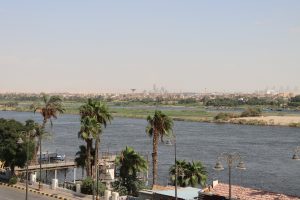
The Grand Ethiopian Renaissance Dam (GERD), built in northwestern Ethiopia, is the largest dam in Africa. Ethiopia plans to produce electricity with the 1.8-kilometer-long, 145-meter-high dam, cutting off water supplies to the downstream riparian states of Sudan and Egypt. The dam is expected to impound 74 billion cubic meters of water.
The project has been a source of heated controversy among the Nile riparians for years. Egypt, whose water needs are met to 97 percent from the Nile, calls the mega-project an existential threat. President Abdel Fattah al-Sisi and Ethiopian head of government Abiy Ahmed agreed in July to reach a deal within four months. In late August, the countries of Egypt, Sudan and Ethiopia began new negotiations. Today, the Nile already carries one-third less water.
Egypt needs the Nile flood, which, due to the monsoon in the Ethiopian highlands, leads to heavy rainfall in the months between May and August and causes the Nile to overflow its banks. Periods of low water flow mean drought and famine in Egypt. Periods of high water flow cause damage to dams and houses. It is not only the water that is important for survival, but also the Nile mud that is carried along with it – very fertile – which consists of sediments and mixes with organic matter on its way to and through Egypt. The floods ensure that the fields are moistened, and the Nile mud provides nutrients for agriculture.



